Since our first trip to Jebel Shams last summer, our whole family is fallen in love with Hajar Mountain ranges in Oman. There is so much to explore in this part of Oman; nature, culture, architecture, history and what not. Besides you can go to Hajar mountains in Oman in summer to escape the heat and enjoy outdoors. Read here what all outdoor fun we had there in July when Dubai is roasting under scorching hot Sun.
At the start of winter, we decided to explore Oman’s Hajar range in cooler weather and we were delighted we did that! This time I wanted to explore famous terrace farms of Oman. With the help of UNESCO world heritage listed Aflaj irrigation system, since centuries Omani people are farming fruits, flowers & grains on their mountains. To see the marvel of this traditional terrace farming and falaj system, you need to visit famous farming villages like Misfat Al Abryeen. The name of this village is also spelled alternatively as ‘Misfah’ Al Abryeen.
How to go to Misfat Al Abryeen
I highly recommend you drive on your own to reach up to Misfat village the drive is not just scenic but fun if you like to mountain driving, a bit steep climbing at some points but the difficulty level is easy to moderate. There are some viewpoints on the way up to the village entrance from where you can see 360-degree panoramic views of Hajar mountain ranges and Al Hamra town! You can easily park your vehicle there and have a picnic, even the garbage bins are kept there.
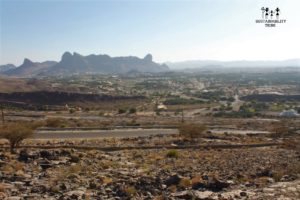
The road is well directed by boards but you can always ask direction to Omani people, they are such great host & very friendly. Here people are mostly farmers since many generations and so proud to tell you all about their farms. There is one public park with children play in a village just before you reach Misfat Village. But if your kids are still not tired after exploring Misfah (which I doubt), you can take them to this park on the way back from Misfah village.
After reaching Misfah Village, you need to park your car at the gate of the village and explore this village on foot, which takes you a few years back. Misfat Village is not a stroller friendly place, as the village is nestled on the slope of the mountain, so if you have younger kids don’t forget your baby carrier. I would suggest everyone read all the rules on the board by Oman Ministry of Tourism at the entrance of the village. For example, it is not allowed here to take photos of villagers without their permission. When we saw a senior villager resting in front of a house, we asked him if we can take a photo, he gave us permission to take his photo for some charges.
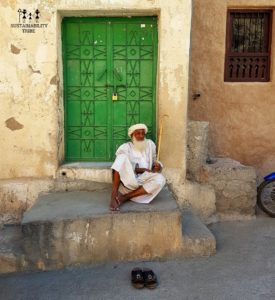
What to see at Misfat Al Abryeen?
The first glimpse at Misfat Village, you will see the riot of palm trees, old houses & ruins rising from the greenery on the slope of the mountain, it’s breathtaking! There are three walking trails to see Misfat Village, you can find them on the board by the ministry of tourism near information. The first route is through the historic part, second is staircase walk and last the garden & wadi walk. But instead of taking any of route, we decided to let our curiosity guide us.

Architectural Marvel of Misfat Village
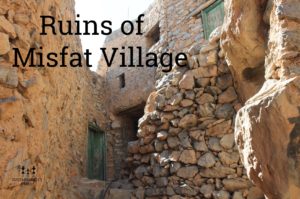
When you enter the ruins, you actually feel like entering the magical world of Arabian nights, so rustic, beautiful, mysterious and even a bit spooky. A few times we ended up at the dead ends and returned back. At a few points, we decided not to enter old ruins, after seeing a lot of cobwebs. These ruins are a great example of traditional Omani architecture. Arabic old arches, shorter entrances of houses, mud & stone walls, traditional wooden beam ceilings, and signature Omani doors, most of them had rust on it which added to so much beauty.
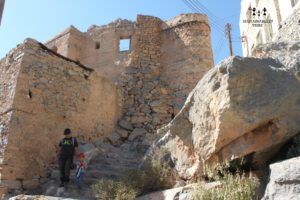
The houses are made with 100% natural materials like mud, stones, wood and are a great example of sustainable development in olden days. These natural materials also help homes to cool down on hotter days. The maze-like narrow shaded paths in the village also add a passive cooling effect. This village is not just one of the most beautiful village in this area but also a living architecture museum!

Most of the houses in historic part are abandoned and are eroding since some time now. But there are still some houses where local farmers are staying and are renovated. Just be careful not to enter in private property. As you keep exploring ruins further and further you start seeing greenery around the houses. The greenery around this old rustic houses makes it such a beautiful sight! Make sure not to pick flowers and fruits from the tree, the livelihood of local people depend on it. If you keep walking further you reach the terrace farms and falaj system.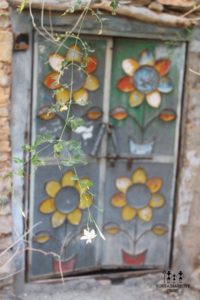
Falaj System of Misfat Village
This an ancient irrigation system found in Arabian Penninsula and prominently seen in this part of Oman. According to UNESCO ‘The origins of this system of irrigation may date back to 500 A.D., but archaeological evidence suggests that irrigation systems existed in this extremely arid area as early as 2,500 B.C’. Five types of Aflaj (plural of falaj) irrigation system in Oman is listed as UNESCO’s world heritage site. I couldn’t find out which type of Falaj system can be seen in Misfat Village. The meaning of word ‘falaj’ is divide or ‘split into parts’. In the Falaj irrigation system, the underground water or spring is split into different water channels (qanat) by using gravity and transported over many kilometers to support agriculture or domestic use. UNESCO mentions ‘sharing of a scarce resource (water) to ensure sustainability remains the hallmark of this irrigation system.’ Traditionally there are many watchtowers to defend Falaj system.
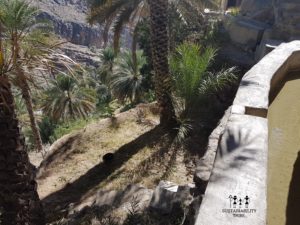
After we reached the Falaj system and started climbing down to terrace farms through narrow steps. My husband announced it’s not safe to take Ruhaan down. The steep descent on one side and mountain on another side, it was not easy to walk on narrow walls of falaj keeping balance to avoid falling in falaj water. So daddy and son decided to sit for story time and I explored Falaj on my own. Just then I saw a group of local farmers with kids walking quickly or even running on same narrow falaj, approached me. They all greeted me with a big smile and waves, I felt such humble and brave people!
I walk on falaj carefully along the mountain width till a found a branch going down the mountain. There were very narrow and uneven steps to go down, I had to be more careful. I wanted to see myself how intelligently they built this irrigation systems many centuries back. and still in use. The falaj here are originally carved from mountain rock and if you follow the falaj you can reach the source of water in the wadi.
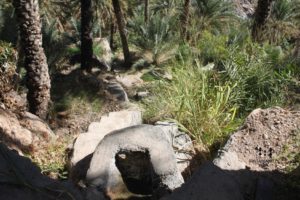
There is also a water reservoir or pool on the falaj system in Misfat village, where local children swim on hotter days. My son enjoyed the sight of water rushing through the falaj taking turns going to the pool.
Terrace Farms of Misfat Village

There are many date palms here and when you go to terrace farms, you walk under the unending shade from the palm trees. Many seasonal fruits are grown here. When we went there in December we could see many pomegranates hanging in the small orchards. You get to see a lot of banana, citrus, papaya, and even mango trees here. When I was walking through these terrace farms I forgot for a moment that I am in Arabian desert, it almost felt like I am in some tropical paradise. We found some small herb patches and flowers like jasmine near the houses inhabited by locals.
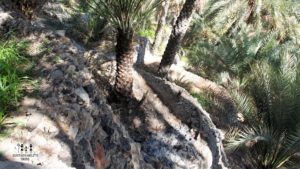
We have been to Bali’s terrace farms which are also listed as UNESCO world heritage site. So it was impossible not to remember that, but both sites are so different. Bali’s beautiful rice terraces are fresh light green, vastly spread and Oman’s terrace farms are narrow, rustic! Both are popular for their traditional irrigation systems. But the beauty of Misfat village terrace farms has a very different charm. I found it more special as it’s also a story of how man conquered natural challenges of the scarcity of water centuries ago to sustain and develop without harming nature, an inspiring sustainable development story from an ancient time!
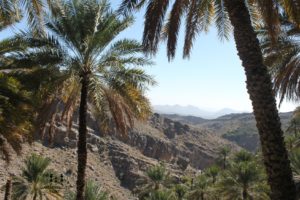
Where to Eat & Stay in Misfat Al Abryeen
If you want to have lunch in Misfat Village, there are options like Misfah Old House but you need to pre-book well in advance. We didn’t plan our Misfat visit that early so we took some take away lunch with us and had an outdoor picnic at a very scenic spot overlooking mountains and terrace farms.
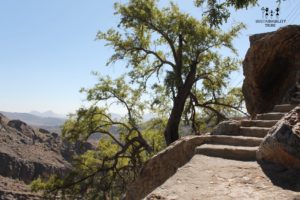
After exploring Misfat Village, we went to Misfah Old House to have tea. It’s a beautiful old house, which also provides traditional Omani style accommodation and even camping on the terrace upstairs along with all meals. The food they serve here is fresh and ingredients are from the nearby terrace farms, a farm to table experience! I tried to book this place for our stay but it was fully booked. So if you want to stay in Misfat Village and see how locals live here then you need to plan ahead and book early.
We had our tea at the majlis seating while talking to other tourists at Misfah Old house overlooking farms & valley. After some relaxation, it was time to go back to the car. I would like to mention just one point here when you are exploring Misfat Village, you are going down the slope of the mountain. Because the parking and entrance of the village at the top, so when you are returning you have to climb up. So remember that when you are exploring especially for families with kids.
It is a great place to take your kids, you can give them farm experience, which is otherwise rare in Arabian Gulf. It’s an active tour, so kids enjoy climbing the stone stairs. Kids find Falaj very interesting, but don’t let them throw things in it as village depends on it for their water requirements. Ruhaan totally loved it there. When we started our car to return to the hotel, Ruhaan was so tired he slept within a few minutes.
Misfat Village nestled in mountains and greenery is definitely a must visit place in Oman!

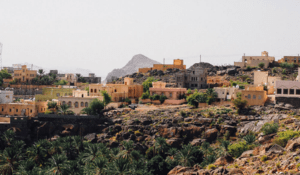
4 Comments
Thank you for the very detailed post! We loved that area of Oman and would love to visit Misfat as well.
Glad you liked the post Sandy, we are so much in love with this place, we have covered almost every part of Dakhliya Region now. 🙂
This place looks absolutely amazing and perfect for a staycation!
Oh yes Paula, it’s fantastic place for staycation and great for whole family!
Comments are closed.